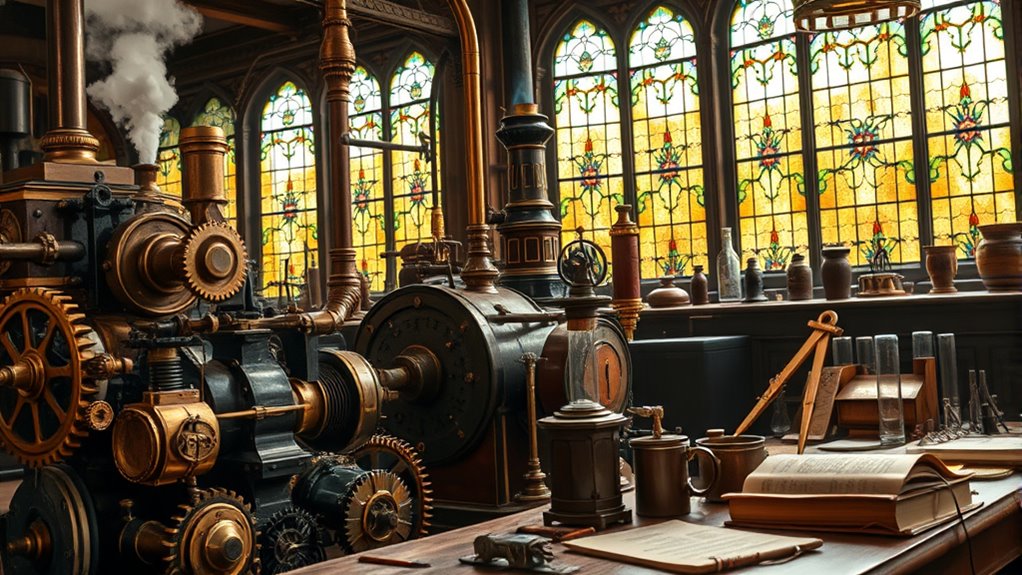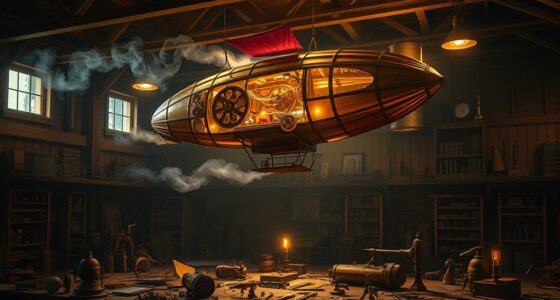Victorian inventions that inspired steampunk technology include intricate automata powered by clockwork mechanisms, showcasing a blend of art and engineering. Pneumatic engines, using compressed air, influenced industrial design with exposed tubing and metallic parts. These innovations embody Victorian ingenuity, emphasizing mechanical beauty and craftsmanship. Their detailed craftsmanship and industrial charm continue to inspire steampunk gadgets, costumes, and machines. If you’re curious about how these ancient inventions shape modern steampunk aesthetics, there’s much more to discover below.
Key Takeaways
- Victorian automata showcased intricate craftsmanship combining art and mechanics, inspiring steampunk aesthetics.
- Pneumatic engines using compressed air influenced the design of steampunk gadgets and industrial machinery.
- Victorian fascination with gears, levers, and clockwork mechanisms laid the foundation for steampunk’s intricate technology.
- Industrial innovation during the era fostered a rugged, mechanical style prominent in steampunk culture.
- Automata and pneumatic tools symbolize Victorian ingenuity, inspiring modern steampunk devices and elaborate costumes.

Have you ever wondered how the Victorian era transformed everyday life? This period was a time of remarkable innovation, laying the groundwork for many technologies that still fascinate us today. Among the most enthralling inventions were clockwork automata and pneumatic engines. These marvels sparked imaginations, blending artistry with engineering prowess, and continue to inspire modern steampunk aesthetics.
Clockwork automata, intricate mechanical figures powered by tiny wind-up mechanisms, captured the Victorian obsession with combining beauty and function. You might imagine a finely crafted automaton performing delicate movements—an intricate dancer, a singing bird, or even a self-playing musical instrument. These automata weren’t just toys; they represented a fascination with precision and mechanical mastery. Their intricate gears and levers demonstrated a deep understanding of mechanics, and their craftsmanship reflected the Victorian desire to blend art with science. When you see modern steampunk designs, you can trace their roots back to these automata, which exemplified the era’s ingenuity and flair for spectacle.
Victorian automata blend art and mechanics, inspiring modern steampunk with their intricate gears and delicate movements.
Pneumatic engines, on the other hand, signified a leap in power and efficiency. These engines used compressed air to generate motion, offering a cleaner and often more reliable alternative to early steam engines. Victorian inventors experimented with pneumatic technology to create innovative tools and machinery—ranging from miniature models to larger industrial applications. You might think of pneumatic engines as the precursors to modern pneumatic tools, which use compressed air to operate. Their development was driven by the Victorian pursuit of progress, pushing the boundaries of what machinery could do. The sleek, industrial aesthetic of pneumatic engines—often visible with exposed tubing and metallic components—inspired countless steampunk contraptions, emphasizing functionality and a rugged, mechanical beauty.
Both clockwork automata and pneumatic engines exemplify how Victorian inventors embraced the mechanical world, seamlessly merging technical precision with artistic design. Their innovations weren’t just practical—they were statements of ingenuity and style. Today, steampunk enthusiasts draw heavily on these inventions, recreating their intricate details and industrial charm. When you encounter a steampunk gadget or costume, you’re witnessing a tribute to Victorian inventors’ ability to transform everyday objects into extraordinary objects of wonder. Their legacy reminds us how curiosity, craftsmanship, and a touch of imagination can turn simple mechanisms into timeless symbols of innovation. Whether in museums, literature, or cosplay, the spirit of Victorian invention continues to inspire those who dream of blending science with style.
Frequently Asked Questions
How Did Victorian-Era Inventions Influence Modern Steampunk Designs?
Victorian-era inventions influence your modern steampunk designs by inspiring intricate details like clockwork automata and steam-powered vehicles. You see how these innovations encourage a blend of Victorian elegance with industrial grit, creating a unique aesthetic. The mechanical complexity of automata and the rugged charm of steam vehicles serve as perfect motifs, allowing you to craft futuristic settings that celebrate the ingenuity and style of the Victorian age while imagining new possibilities.
Were There Any Inventions During the Victorian Era That Failed but Inspired Later Tech?
Yes, during the industrial revolution, some Victorian inventions like early textile machinery failed initially but inspired later innovations. You can see how these failures pushed engineers to refine designs, leading to more efficient technology. These setbacks helped shape the development of modern machinery, and their influence persists in steampunk aesthetics today. You benefit from understanding how perseverance through failure during the Victorian era fueled progress in textile machinery and other inventions.
What Materials Were Commonly Used in Victorian Inventions That Impacted Steampunk Aesthetics?
You notice that Victorian inventions often used ornate brass and vintage glass, shaping the steampunk aesthetic. These materials give steampunk its signature blend of elegance and industrial grit. Brass adds a warm, antique shine; vintage glass offers a delicate, intricate appeal. You see how these materials create a timeless look, combining craftsmanship, durability, and beauty—making every piece feel both historic and imaginative, perfect for the steampunk world.
Did Victorian Inventors Collaborate Across Industries to Create Multifunctional Devices?
Victorian inventors often collaborated across industries to develop multifunctional devices, blending ideas from engineering, chemistry, and mechanics. You’ll find that such cross-industry collaboration led to innovative inventions that combined multiple functions, making devices more efficient and versatile. This approach fostered creativity and progress, inspiring steampunk technology with its complex, multifunctional gadgets. By working together across disciplines, Victorian inventors pushed the boundaries of what devices could do, shaping the aesthetic and functionality of steampunk design.
How Did Victorian Societal Needs Shape the Development of Innovative Technologies?
Think of Victorian society as a grand chessboard, where social hierarchy dictated moves and innovations. You see, societal needs pushed technological innovation, aiming to improve daily life and reinforce class distinctions. Wealthy elites funded inventions to showcase status, while workers sought tools for efficiency. This dynamic shaped a wave of inventions, blending practicality with spectacle, ultimately fueling the era’s inventive spirit and inspiring the imaginative world of steampunk.
Conclusion
As you explore Victorian inventions, remember they’re more than just mechanical marvels—they’re the seeds of imagination and innovation. Like the gears turning in a steampunk world, these inventions remind us that progress is fueled by curiosity and daring. So, next time you see a clockwork device or steam-powered machine, ask yourself: are we truly inventing a future, or simply reviving a timeless dream? After all, history’s greatest inventions are the echoes of our own imagination.









